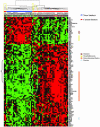Effects of cigarette smoke on the human airway epithelial cell transcriptome
- PMID: 15210990
- PMCID: PMC454179
- DOI: 10.1073/pnas.0401422101
Effects of cigarette smoke on the human airway epithelial cell transcriptome
Abstract
Cigarette smoke is the major cause of lung cancer, the leading cause of cancer death, and of chronic obstructive pulmonary disease, the fourth leading cause of death in the United States. Using high-density gene expression arrays, we describe genes that are normally expressed in a subset of human airway epithelial cells obtained at bronchoscopy (the airway transcriptome), define how cigarette smoking alters the transcriptome, and detail the effects of variables, such as cumulative exposure, age, sex, and race, on cigarette smoke-induced changes in gene expression. We also determine which changes in gene expression are and are not reversible when smoking is discontinued. The persistent altered expression of a subset of genes in former smokers may explain the risk these individuals have for developing lung cancer long after they have discontinued smoking. The use of gene expression profiling to explore the normal biology of a specific subset of cells within a complex organ across a broad spectrum of healthy individuals and to define the reversible and irreversible genetic effects of cigarette smoke on human airway epithelial cells has not been previously reported.
Figures



References
-
- Proctor, R. N. (2001) Nat. Rev. Cancer 1, 82-86. - PubMed
-
- Greenlee, R. T., Hill-Harmon, M. B., Murray, T. & Thun, M. (2001) CA Cancer J. Clin. 51, 15-36. - PubMed
-
- Hecht, S. S. (2003) Nat. Rev. Cancer 3, 733-744. - PubMed
-
- Anderson, R. & Smith, B. (2003) Natl. Vital Stat. Rep. 52, 7-11.
-
- Shields, P. G. (1999) Ann. Oncol. 10, Suppl. 5, S7-S11. - PubMed
Publication types
MeSH terms
Grants and funding
LinkOut - more resources
Full Text Sources
Other Literature Sources
Molecular Biology Databases

